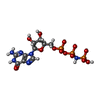+Search query
-Structure paper
| Title | Receptor compaction and GTPase rearrangement drive SRP-mediated cotranslational protein translocation into the ER. |
|---|---|
| Journal, issue, pages | Sci Adv, Vol. 7, Issue 21, Year 2021 |
| Publish date | May 21, 2021 |
 Authors Authors | Jae Ho Lee / Ahmad Jomaa / SangYoon Chung / Yu-Hsien Hwang Fu / Ruilin Qian / Xuemeng Sun / Hao-Hsuan Hsieh / Sowmya Chandrasekar / Xiaotian Bi / Simone Mattei / Daniel Boehringer / Shimon Weiss / Nenad Ban / Shu-Ou Shan /    |
| PubMed Abstract | The conserved signal recognition particle (SRP) cotranslationally delivers ~30% of the proteome to the eukaryotic endoplasmic reticulum (ER). The molecular mechanism by which eukaryotic SRP ...The conserved signal recognition particle (SRP) cotranslationally delivers ~30% of the proteome to the eukaryotic endoplasmic reticulum (ER). The molecular mechanism by which eukaryotic SRP transitions from cargo recognition in the cytosol to protein translocation at the ER is not understood. Here, structural, biochemical, and single-molecule studies show that this transition requires multiple sequential conformational rearrangements in the targeting complex initiated by guanosine triphosphatase (GTPase)-driven compaction of the SRP receptor (SR). Disruption of these rearrangements, particularly in mutant SRP54 linked to severe congenital neutropenia, uncouples the SRP/SR GTPase cycle from protein translocation. Structures of targeting intermediates reveal the molecular basis of early SRP-SR recognition and emphasize the role of eukaryote-specific elements in regulating targeting. Our results provide a molecular model for the structural and functional transitions of SRP throughout the targeting cycle and show that these transitions provide important points for biological regulation that can be perturbed in genetic diseases. |
 External links External links |  Sci Adv / Sci Adv /  PubMed:34020957 / PubMed:34020957 /  PubMed Central PubMed Central |
| Methods | EM (single particle) |
| Resolution | 3.2 - 7.2 Å |
| Structure data | EMDB-12303, PDB-7nfx:  EMDB-12304:  EMDB-12305: |
| Chemicals |  ChemComp-ZN:  ChemComp-MG:  ChemComp-GTP:  ChemComp-GNP: |
| Source |
|
 Keywords Keywords |  RIBOSOME / RIBOSOME /  Signal recognition particle / protein targeting to the ER membrane Signal recognition particle / protein targeting to the ER membrane |
 Movie
Movie Controller
Controller Structure viewers
Structure viewers About Yorodumi Papers
About Yorodumi Papers







